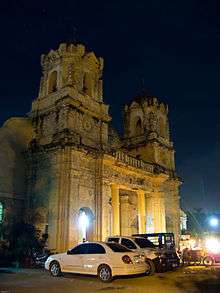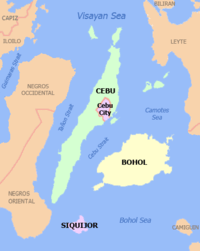Talisay, Cebu
| Talisay | ||
|---|---|---|
| Component City | ||
| City of Talisay | ||
|
Talisay City Hall | ||
| ||
 Map of Cebu with Talisay highlighted | ||
.svg.png) Talisay Location within the Philippines | ||
| Coordinates: 10°15′N 123°50′E / 10.25°N 123.83°ECoordinates: 10°15′N 123°50′E / 10.25°N 123.83°E | ||
| Country | Philippines | |
| Region | Central Visayas (Region VII) | |
| Province | Cebu | |
| District | 1st district of Cebu | |
| Founded Incorporated (town) Incorporated (city) |
1648 1849 30 December 2000 | |
| Barangay | 22 (see § Barangays) | |
| Government [1] | ||
| • Type | Sangguniang Panlungsod | |
| • Mayor | Eduardo Gullas (NP) | |
| • Vice mayor | Alan Bucao (NP) | |
| • City Council |
Members
| |
| • Representative | Gerald Anthony Gullas Jr.[2] | |
| Area[3] | ||
| • Total | 39.87 km2 (15.39 sq mi) | |
| Population (2015 census)[4] | ||
| • Total | 227,645 | |
| • Density | 5,700/km2 (15,000/sq mi) | |
| • Voter (2016)[5] | 120,240 | |
| Time zone | PST (UTC+8) | |
| ZIP code | 6045 | |
| IDD : area code | +63 (0)32 | |
| Income class | 3rd class | |
| PSGC | 072250000 | |
| Website |
www | |
Talisay, officially the City of Talisay and often referred to as Talisay City, is a 3rd city income class component city in the province of Cebu, Philippines. According to the 2015 census, it has a population of 227,645.[4] In the 2016 election, it had 120,240 registered voters.[5] Primarily a residential and trading center, Talisay lies within the Metro Cebu area.
The name of Talisay is taken from the magtalisay tree which is abundant in the city.
History
Talisay was founded in 1648 as an estate owned by the Augustinians. In 1849 it was converted into a municipality.
During both the American colonial period and World War II, Talisay served as a haven of colonial military forces. The municipality served as the center of guerrilla intelligence operations for the Philippine resistance movement in Cebu during World War II. The returning U.S. liberation forces landed on the beaches of Talisay on 28 March 1945, and were helped together with the Philippine Commonwealth forces and the Cebuano guerrillas, an event that marked the eventual surrender of Japanese forces on Cebu. That day is now an official holiday in the province of Cebu.
In 2000 the municipality of Talisay was converted into a city.[6] The municipality is now linked to Cebu City via the new South Coastal Highway from Lawaan, opened in 2004. This brought some recent inward investment in the form of sub-divisions, but some hastily planned plagued by problems. Conflict occurred between the residents of the mountain barangay of Maghaway and those of Crown Asia's Azienda Milan and Venezia sub-divisions. According to the National Statistics Office in its 2000 report, some 70 percent of the population of Talisay belongs to the urban poor. Talisay remains an important center for the production of blasting caps used in dynamite.
Barangays
Talisay City comprises 22 barangays:[3]
| PSGC | Barangay | Population | ±% p.a. | ||
|---|---|---|---|---|---|
| 2015[4] | 2010[7] | ||||
| 072250019 | Biasong | 2.8% | 6,482 | 1,755 | +28.25% |
| 072250001 | Bulacao | 5.6% | 12,697 | 11,579 | +1.77% |
| 072250020 | Camp IV | 1.5% | 3,305 | 2,258 | +7.52% |
| 072250002 | Candulawan | 1.9% | 4,379 | 3,812 | +2.68% |
| 072250003 | Cansojong | 7.0% | 16,016 | 12,645 | +4.60% |
| 072250004 | Dumlog | 7.8% | 17,785 | 12,709 | +6.61% |
| 072250005 | Jaclupan | 3.8% | 8,684 | 7,891 | +1.84% |
| 072250006 | Lagtang | 6.1% | 13,830 | 10,394 | +5.59% |
| 072250007 | Lawaan I | 4.1% | 9,413 | 9,503 | −0.18% |
| 072250021 | Lawaan II | 2.7% | 6,033 | 5,625 | +1.34% |
| 072250022 | Lawaan III | 5.3% | 12,037 | 10,708 | +2.25% |
| 072250008 | Linao | 4.4% | 10,110 | 7,951 | +4.68% |
| 072250009 | Maghaway | 3.1% | 7,148 | 6,869 | +0.76% |
| 072250010 | Manipis | 1.1% | 2,456 | 1,994 | +4.05% |
| 072250011 | Mohon | 4.7% | 10,735 | 9,582 | +2.19% |
| 072250012 | Poblacion | 5.6% | 12,756 | 12,107 | +1.00% |
| 072250013 | Pooc | 5.1% | 11,699 | 8,912 | +5.32% |
| 072250014 | San Isidro | 6.0% | 13,753 | 12,502 | +1.83% |
| 072250015 | San Roque | 8.0% | 18,161 | 16,950 | +1.32% |
| 072250016 | Tabunoc | 6.4% | 14,682 | 17,593 | −3.39% |
| 072250017 | Tangke | 6.0% | 13,707 | 11,891 | +2.74% |
| 072250018 | Tapul | 0.8% | 1,777 | 5,238 | −18.60% |
| Total | 227,645 | 200,772 | +2.42% | ||
Demographics
| Population census of Talisay | |||||||||||||||||||||||||||||||
|---|---|---|---|---|---|---|---|---|---|---|---|---|---|---|---|---|---|---|---|---|---|---|---|---|---|---|---|---|---|---|---|
|
| ||||||||||||||||||||||||||||||
| Source: Philippine Statistics Office[4][7][8] | |||||||||||||||||||||||||||||||
In the 2016 election, it had 120,240 registered voters, meaning that 53% of the population are aged 18 and over.[5]
Cebuano is the predominant language of the inhabitants of the city (96%).
Religion

Talisay City has 90% Roman Catholic population with 9% other Christian denomination and 1% Muslim.
Churches and shrines
Roman Catholic churches:
- Archdiocesan Shrine of St. Teresa of Avila
- St. Joseph the Worker
- San Isidro Labrador
- Sto. Niño de Cebu
- Our Mother of Perpetual Help
- La Consolacion Parish – Recoletos
- Archdiocesan Shrine of Jesus Nazareno
- Archdiocesan Shrine of Our Lady of Schoenstatt
Other denomination churches:
- Cirila Uy Sy Memorial
- Lagtang Seventh-Day Adventist
- Bulacao Seventh-Day Adventist
- Talisay First Assembly of God
- Church of Jesus Christ of Latter-day Saints
Economy
Much of the commerce in Talisay takes place in the Tabunok area, where several public markets, strip malls and commercial establishments are situated. The biggest mall is Gaisano Grand Fiesta Mall Tabunok, which has a supermarket, department store and cinema. However, much of the population still depend on the public markets, where they can find fresh meat, fish and vegetables, as well as other household needs. There are many sari-sari stores. Talisay City and the Tabunok area also serve as the commercial area for municipalities south of the city, being the southern gateway to Cebu City.
Transport
Talisay City, its citizens and its surrounding barangays have benefitted from the construction of the South Road Properties project, which is a 6-lane coastal highway from downtown Cebu City to the town of Minglanilla, with several exits in between, many of which serve several areas of Talisay. Because of this highway, traffic, which has always been a problem for the inhabitants in the past few years for this area, has been greatly reduced, making the city a popular zone for housing once more, as it was in the early 70s and 80s.
In 2016 Talisay City Council expressed support for the proposed Light Rail Transit (LRT) project in Cebu.[9]
Education
- 20 Elementary schools (Private & Public)
- 12 Public secondary schools
- 8 Private secondary schools
- 3 Colleges
- 5 Kindergartens
- 5 Seminaries
Tourism
Attractions in Talisay include:
- Aqua Cainta
- Crocolandia
- The Igutan Cave
- Sta. Teresa de Avila Church
- Lagundi Reef
- Sealights
- Talisay City Butterfly Park
- Talisay Liberation Park
- Villa Teresita
Festivals
- 12 January
- Talisay City Charter Day
- 26 March
- American Landing Anniversary – a parade and re-enactment from the Armed Forces and war veterans highlight the yearly celebration to honor and remember the American and Filipino soldiers who liberated the province of Cebu from the hands of the Japanese.
- 16 August
- Founding Day – the city commemorates its Foundation day celebration with a series of week-long cultural sports and other events
- 15 October
- Fiesta Sa Talisay – the city celebrates its annual fiesta in honor of Sta. Teresa de Avila
- Halad Kang Santa Teresa– an offering of thanksgiving in the form of dance by local Talisaynons and pilgrims to pay homage to Sta. Teresa de Avila, the city's patroness. People from all walks of life flock to the city to dance, offer and join the merriment.
- Inasal Festival – lechon inasal is served in every resident's banquet. The festival is a showcase of lechons in various costumes and decorations.
References
- ↑ "City". Quezon City, Philippines: Department of the Interior and Local Government. Retrieved 30 May 2013.
- ↑ http://www.congress.gov.ph/members/search.php?id=gullas-g
- 1 2 "Municipal: Talisay, Cebu". PSGC Interactive. Quezon City, Philippines: Philippine Statistics Authority. Retrieved 8 January 2016.
- 1 2 3 4 "Region VII (CENTRAL VISAYAS)". Census of Population (2015): Total Population by Province, City, Municipality and Barangay (Report). PSA. Retrieved 20 June 2016.
- 1 2 3 "2016 National and Local Elections Statistics". Commission on Elections. 2016.
- ↑ NSCB - 2001 Factsheet - 12 New Cities Created, July–December 2000.
- 1 2 "Region VII (CENTRAL VISAYAS)". Census of Population and Housing (2010): Total Population by Province, City, Municipality and Barangay (Report). NSO. Retrieved 29 June 2016.
- ↑ "Region VII (CENTRAL VISAYAS)". Census of Population (1995, 2000 and 2007): Total Population by Province, City and Municipality (Report). NSO. Archived from the original on 24 June 2011.
- ↑ Sun Star Cebu 2016.
Sources
- Gonzales, Glenda R. (December 2004). "Metro Cebu: A Metropolitan Area in Need of Coordinative Body" (PDF). DISCUSSION PAPER. 2004-49. Philippine Institute for Development Studies. Retrieved 16 February 2016.
- Sun Star Cebu, Justin K. Vestil (5 August 2016). "LRT system gets backing of Talisay council". Archived from the original on 6 August 2016.
| Wikimedia Commons has media related to Talisay. |
External links
 |
Cebu City |  | ||
| Minglanilla | |
Cebu City | ||
| ||||
| | ||||
| Cebu Strait |


